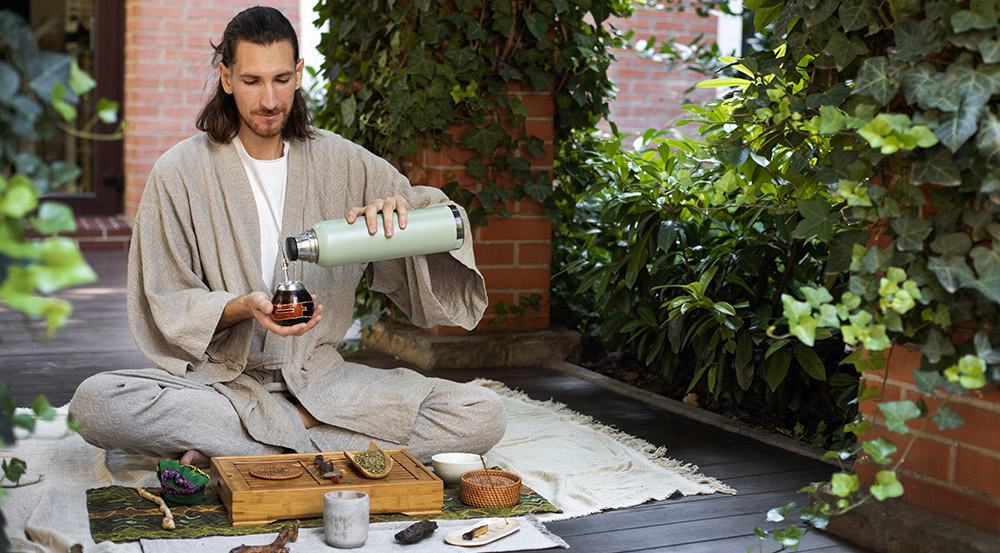(A Journey Through the Energies That Shape You)
In Ayurveda, you are not just bones and blood. You are wind, fire, and earth in motion. The way you think, eat, sleep, love, react, digest, and even heal — all of it dances to the rhythm of your dosha.
These doshas — Vata, Pitta, and Kapha — are the three biological energies that govern every function of your body and mind. But they are more than systems.
They are stories written in your breath, your skin, your habits, and your triggers.
Let’s step into the world of each one — not as categories, but as living, breathing archetypes.
Vata: The Wind That Moves You
Elements: Air + Ether
Qualities: Light, dry, cold, mobile, irregular
Seat: Colon, bones, nervous system, breath
Season: Late autumn to early winter
Vata is the dancer of the doshas. Quick to move, quick to change. It governs creativity, movement, communication, and flow.
When balanced, Vata gives rise to inspiration, flexibility, and joy.
But when it blows too strong?
You feel anxious, ungrounded, forgetful
Digestion turns to bloating or constipation
Sleep becomes light or broken
Your skin is dry, your hands cold, and your thoughts restless
Bring Vata back to balance with:
- Warm, moist, oily foods (think soups, ghee, stews)
- Abhyanga (self-massage with sesame oil)
- Routine, stillness, and early bedtimes
- Grounding yoga and breathwork
- Saying “no” to overstimulation and multitasking
“When Vata is calm, inspiration becomes nourishment rather than a storm.”
Pitta: The Fire That Transforms You
Elements: Fire + Water
Qualities: Hot, sharp, oily, intense, penetrating
Seat: Small intestine, liver, eyes, blood
Season: Summer
Pitta is your inner fire — the force of digestion, metabolism, ambition, and sharp thinking. It fuels your intellect and willpower. A balanced Pitta is the inner fire that forges clarity, decisiveness, and strength — without burning out.
But when it overheats?
You feel irritable, critical, impatient
Skin may show acne, rashes, inflammation
Digestion becomes too strong — acidity, heartburn, loose stools
You burn out emotionally, mentally, and physically
Cool and soothe Pitta with:
- Cooling, hydrating foods (like cucumbers, coconut, mint)
- Rose water, aloe vera, and sandalwood
- Avoiding overwork and competition
- Spending time in nature and near water
- Practicing calming yoga and meditation
“When Pitta surrenders to softness, brilliance becomes compassionate.”
Kapha: The Earth That Holds You
Elements: Earth + Water
Qualities: Heavy, slow, steady, moist, smooth, dense
Seat: Lungs, stomach, lymph, joints
Season: Late winter to spring
Kapha is the glue and cushion of life. It governs structure, stability, love, and immunity. When Kapha is in harmony, you become a steady mountain — grounded, gentle, and unshakably resilient.
But when it accumulates too much?
You feel sluggish, lethargic, foggy
Weight gain, congestion, and water retention appear
You may feel emotionally stuck, overly attached, or depressed
Lighten Kapha with:
- Warm, spicy, dry foods (like ginger tea, sautéed greens, light grains)
- Movement, heat, and stimulation
- Dry brushing and energizing practices
- Saying “yes” to change and letting go of excess
“When Kapha learns to move, it becomes grace — not gravity.”
But What If You’re More Than One? You are.
Most people are a blend — Vata-Pitta, Pitta-Kapha, Vata-Kapha, or all three in unique proportions. Your Prakriti (birth constitution) is your energetic fingerprint. Your Vikruti (current imbalance) is your real-time map.
Ayurveda isn’t a label — it’s a mirror that shifts with your breath, your season, your story.
Your job is to notice, nourish, and rebalance as life changes shape around you.
Final Thought: Your Dosha Is Not a Label — It’s a Compass
Knowing your dosha isn’t about identifying your “type” and moving on.
It’s about understanding how nature lives inside you, and learning how to realign when life pulls you off course.
Vata shows you how to move.
Pitta teaches you how to transform.
Kapha reminds you how to stay.
Together, they are your inner trinity — the pulse of your unique rhythm.







